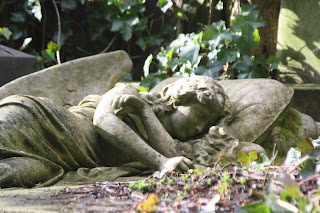When i visited Highgate Cemetery I explored the East side as well as the West side. The East side is still a working cemetery and so there are a lot of newer graves than there are in the West side, there are also a few unique and interesting memorials worth seeing.
The East side is best known for being home to the tomb of Karl Marx, which is impossible to miss seems to be constantly surrounded by a swarm of tourists. It has been so well documented, though, that it didn't seem that special to me.

One of the first graves as you enter the East side of the cemetery belongs to Anna Mahler, a sculpture. The memorial on her grave is a copy of one of her own sculptures which gives it a great sense of uniqueness.

Another grave close to the entrance is of Douglas Adams, writer of 'The Hitchhiker's Guide to the Galaxy'. The memorial in itself is very plain but what maked it interesting is the small toys that have been left by fans on top of the stone.

Despite still being a working cemetery with many modern graves the cemetery was unused for such a long time that there are still many graves that are enshrouded with ivy and other plant life, there are also many narrow winding paths crisscrossing the cemetery but these are so overgrown that you are unable to walk down them.





 Much like an angel in Charlton Cemetery she had a mark over one of her eyes produced by weather over time.
Much like an angel in Charlton Cemetery she had a mark over one of her eyes produced by weather over time. I have been unable to find out any significant features about her or her life other than she ran factories that produced brass musical instruments.
I have been unable to find out any significant features about her or her life other than she ran factories that produced brass musical instruments.




 One of the first graves as you enter the East side of the cemetery belongs to Anna Mahler, a sculpture. The memorial on her grave is a copy of one of her own sculptures which gives it a great sense of uniqueness.
One of the first graves as you enter the East side of the cemetery belongs to Anna Mahler, a sculpture. The memorial on her grave is a copy of one of her own sculptures which gives it a great sense of uniqueness.  Another grave close to the entrance is of Douglas Adams, writer of 'The Hitchhiker's Guide to the Galaxy'. The memorial in itself is very plain but what maked it interesting is the small toys that have been left by fans on top of the stone.
Another grave close to the entrance is of Douglas Adams, writer of 'The Hitchhiker's Guide to the Galaxy'. The memorial in itself is very plain but what maked it interesting is the small toys that have been left by fans on top of the stone. Despite still being a working cemetery with many modern graves the cemetery was unused for such a long time that there are still many graves that are enshrouded with ivy and other plant life, there are also many narrow winding paths crisscrossing the cemetery but these are so overgrown that you are unable to walk down them.
Despite still being a working cemetery with many modern graves the cemetery was unused for such a long time that there are still many graves that are enshrouded with ivy and other plant life, there are also many narrow winding paths crisscrossing the cemetery but these are so overgrown that you are unable to walk down them.




 Thomas Sayers was the first man to be declared the World Heavy Weight Champion in the sport of Boxing. Throughout his career he was only ever defeated once. When he retired he settled in a house in Camden where he was often seen driving his carriage up and down the streets with his Bull Mastiff 'Lion'.
Thomas Sayers was the first man to be declared the World Heavy Weight Champion in the sport of Boxing. Throughout his career he was only ever defeated once. When he retired he settled in a house in Camden where he was often seen driving his carriage up and down the streets with his Bull Mastiff 'Lion'.  He died at the age of 39 of Tuberculosis and Diebeties. At the time of his death he was so famous that his funeral was attended by ten thousand people. His friends pulled together to pay for his tomb, which bears a statue of his beloved dog.
He died at the age of 39 of Tuberculosis and Diebeties. At the time of his death he was so famous that his funeral was attended by ten thousand people. His friends pulled together to pay for his tomb, which bears a statue of his beloved dog.



 Also spotted was this example of a death mask. A death mask is an actual mold of the deceased face that is then turned into a mask and put upon a memorial statue. This creates a copy of the deceased faces on their memorial.
Also spotted was this example of a death mask. A death mask is an actual mold of the deceased face that is then turned into a mask and put upon a memorial statue. This creates a copy of the deceased faces on their memorial. 